
Study Links Socioeconomic Deprivation to Severity of Rhegmatogenous Retinal Detachment
A recent study indicates that patients living in socioeconomically deprived neighborhoods are more likely to present with severe rhegmatogenous retinal detachment (RRD), a serious eye condition that can lead to vision loss if not treated promptly. Adverse social determinants of health (SDOH) appear to impact access to timely care, thereby affecting visual outcomes.
Study Overview: Impact of Socioeconomic Factors on RRD Severity
The retrospective cohort study, conducted at the Wilmer Eye Institute, evaluated adult patients undergoing RRD repair between 2008 and 2018. Researchers analyzed data from 700 patients (268 women and 432 men) from 19 states, assessing the association between neighborhood-level SDOH and RRD severity, specifically in terms of visual acuity and foveal involvement at presentation.
Key factors examined included:
• Visual Acuity: Whether patients presented with better or worse than 20/40 vision.
• Foveal Status: Whether the RRD was fovea-involving or fovea-sparing at presentation.
Neighborhood-Level Social Determinants of Health and Their Influence on RRD Severity
Patient addresses were geocoded and matched with neighborhood SDOH, such as the Area Deprivation Index (ADI), per capita income, insurance type, percentage of uninsured individuals, and transportation methods.
The study revealed:
• Higher ADI Scores: Patients from neighborhoods with higher ADI scores, lower per capita income, and a greater reliance on driving for transportation were more likely to present with severe RRD, characterized by visual acuity worse than 20/40 and fovea-involving RRD.
• Income and Vision: For each $1,000 increase in per capita income, the odds of presenting with worse vision decreased.
Patient Demographics and Risk Factors for Severe RRD
The study also found that certain patient demographics were associated with more severe RRD presentations:
• Age and Race: Older patients and non-Hispanic Black patients had higher rates of severe RRD.
• Insurance Status: Patients with public insurance or without insurance were more likely to present with advanced RRD.
Implications for Policy and Interventions
The authors highlighted that these findings could guide policy and interventions targeting vulnerable neighborhoods.
“Findings from this study might help highlight neighborhoods that will benefit from policy changes and interventions that promote earlier presentation with RRD. Ultimately, interventions targeting these vulnerable populations may lead to earlier surgical repair, improved functional outcomes, reduced complication rates, and reduced health care spending.”
By addressing social determinants of health, such interventions could facilitate earlier diagnosis and treatment of RRD, improving patient outcomes and potentially reducing healthcare costs.
Resource:
Ong SS, et al. JAMA Ophthalmol. 2024;doi:10.1001/jamaophthalmol.2024.2889.
(1).jpg)










